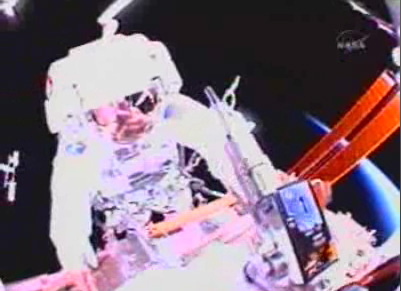Spacewalk Scrap: ISS Astronauts Toss Space Junk

Thisstory was updated at 5:11 p.m. EDT.
With a biglean back and a giant push forward, American astronaut Clayton Anderson heaveda 1,400-pound (635-kilogram) tank of ammonia from the International SpaceStation today (ISS).
"Jettison!"Anderson shouted shortly after tossing the unneeded refrigerator-sizedcontainer from the robotic arm of the station.
The junkingof equipment was one of two today during the seven-hour-and-41-minute spacewalkthat began at about 200 miles above the Earth. Cosmonaut Fyodor Yurchikhinjoined Anderson outside, while cosmonaut Oleg Kotov maneuvered the station'sCanadian-built robotic arm around with Anderson on the end.
"Thisis the first day and the first time a Russian cosmonaut has operated, in orbit,the [station's] robotic arm," Anderson said, adding his appreciation forYurchikhin's participation. "I'm very appreciative of their work."
"Fyodor,come outside and play," Andersontold Yurchikhin once he emerged from the U.S. Unity module's airlock at 6:24a.m. (1024) GMT, officially beginning the spacewalk.
Time tojettison
Get the Space.com Newsletter
Breaking space news, the latest updates on rocket launches, skywatching events and more!
Onceoutside, Anderson and Yurchikhin began installing a video stanchion, or supportframe, on one of the station's trusses. The equipment will be used to hold avideo camera that will assist with future expansion of the ISS.
The twothen separated, with Yurchikhin replacing a failed circuit breaker for thestation's truss-based rail car system, and Anderson disconnecting cablinghooked up to the tank of unneeded ammonia coolant.
"Ourspaceship Earth is a beautiful place," Anderson said while describing hisview outside of the growing international laboratory.
Around 8:55a.m. EDT (1255 GMT), Anderson snapped into the foothold on the space station'srobotic arm, then moved out into space with 212 pounds (96 kilograms) of flightsupport equipment that previously held the stanchion into place.
Using amaneuver practiced back on Earth, Anderson leaned back, then forward and gavethe equipment a mighty push intospace.
"It lookspretty cool, like a huge star, and the brightness of it changes as itrotates," Anderson said of the careening hunk of equipment, which he threwmore than 1 foot (30 cm) per second. He then joked about the success of thethrow.
"I'llbe sending my bill in the mail for garbage disposal," he told missioncontrol in at Johnson Space Center in Houston, Texas following the jettison.NASA expects the object to burn up in the Earth's atmosphere within 330 days.
Yurchikhinthen assisted Anderson with disconnecting the second junked equipment, thistime the 1,400-pound (635-kilogram) backup reservoirof ammonia. NASA said in several briefings that the tank had reached the"end of its life," as far as its structural integrity was concerned,and was no longer needed on the ISS. Discarding the equipment also helped clearthe station’s mast-like Port 6 truss for relocation later this year,mission managers have said.
After thebig toss, Anderson requested that mission control call his family and tell themhe "just threwa 17,500-mile-an-hour fastball."
NASA will keep a close watch on the adrift ammonia tank andvideo camera stanchion support frame as they spiral towards Earth to ensurethey don’t post a risk to the ISS or other spacecraft. Mission managersplan to boost the space station’s orbit later tonight to provide extraclearance and ready the orbital laboratory for the arrival of an unmannedRussian cargo ship and NASA’s Endeavour shuttle crew next month.
Extrainnings
After thedangerous task of tossing space junk was complete, the astronauts began work onother projects.
Yurchikhinmoved to the Unity module, where he enlisted a scraping device to clean offspots of grime which had stuck to a common berthing mechanism (CBM), or finesilicon seal.
"There'sa lot of debris there," Yurchikhin said as he scraped the grit away. Thecosmonaut described the material as an oily substance mixed with bits of hairand possibly paper. "It just spreads everywhere."
The cleanedseal will ensure an airtight connection when the station’s Expedition 15crew moves a pressurized mating adapter later this year.
WhileYurchikhin cleaned, Anderson maneuvered himself off of the robotic arm andremoved a faulty global positioning satellite (GPS) antenna outsideof the space station.
"One GPS is in the bag,"Anderson said after unbolting the basketball-sized device, whichis one of four on the ISS. The project came as an addition to the check-list,as the both astronauts made good time in completing their tasks.
As thespacewalk neared its end, Yurchikhin began to clean up and look for stray toolsand bags of equipment. Meanwhile, mission control instructed Anderson to loosensome bolts in preparation for future expansion of the space station.
Both astronautsclimbed inside the airlock and closed the hatch at about 2:06 p.m. EDT (1604GMT), making for a total spacewalk time of seven hours and 41 minutes. Thespacewalk marked Anderson's first time outside the ISS and Yurchikhin's third.
"We truly thank you for yourperfect execution," mission control said shortly before the hatch closed.
- IMAGES: Space Tourist, Expedition 15 Crew Train for Launch
- VIDEO: Space Tourist Charles Simonyi in Zero G!
- Complete International Space Station Mission Coverage
Join our Space Forums to keep talking space on the latest missions, night sky and more! And if you have a news tip, correction or comment, let us know at: community@space.com.
Dave Mosher is currently a public relations executive at AST SpaceMobile, which aims to bring mobile broadband internet access to the half of humanity that currently lacks it. Before joining AST SpaceMobile, he was a senior correspondent at Insider and the online director at Popular Science. He has written for several news outlets in addition to Live Science and Space.com, including: Wired.com, National Geographic News, Scientific American, Simons Foundation and Discover Magazine.









